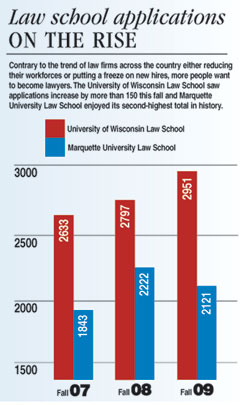
A September 14 article in the Wisconsin Law Journal (noted elsewhere on this website) included the chart to the left. Although the story was innocuous enough, reporting that applications to law school in Wisconsin went up last year in spite of the economic downturn, the accompanying chart gives the impression that applications to the University of Wisconsin Law School dramatically exceed those of Marquette. A quick glance seems to suggest that for the fall of 2009, Wisconsin received more than twice as many applications as Marquette since the red bar appears to be more than twice as long as the blue bar.
That isn’t true, and the problem is the misleading presentation of the graph.
While it is true that Wisconsin does receive more applications than Marquette, the discrepancy is not nearly as great as the graph seems to suggest. The problem, as anyone who looks at the graph carefully will see, is that it reproduces only the top half of the bar graph showing the relative number of applications at the two law schools.
In fact, if one looks at the entire graph, then it becomes clear that the Wisconsin lead is a more modest one. For the fall of 2007, Marquette’s application total was 68% of the Madison total. For 2008, the number jumped to 79%, before falling back to 72% for 2009. Until 2009, Marquette had been gaining on Madison at a fairly rapid pace. It seems likely that, in a time of economic downturn, the fact that private Marquette has a much higher tuition than public Wisconsin served to discourage applicants who may well have applied in the past.

Prof. Hylton, you’re quite right to point out the tuition differential between UW and MU. In these tough economic times, perhaps the State Legislature should ask if it should continue to subsidize tuition at UW Law. A few years ago, then-State Rep. Frank Lasee from Green Bay proposed phasing out state taxpayer funding for UW Law, which would force the school to raise tuition to make up for the state aid. His reasoning was that Wisconsinites “don’t need more ambulance chasers. We don’t need frivolous lawsuits…. And I think that having too many attorneys leads to all those bad results.” Lasee’s proposal was lampooned, mocked, and poo-poohed by the chattering classes and powers that be. And admittedly, he wasn’t a great messenger given his own personal frustrations with the legal system.
But underlying it was a fair question. Should Wisconsin taxpayers subsidize the education of more lawyers? The Wisconsin per capita personal income is $33,251. Not a single member of the UW Law Class of 2007 made less than that in their first job after graduation. The median private sector salary was $105,000; the median public sector salary was $46,000 (two-thirds of grads go into the private sector). Given those three numbers, I think it’s fair to ask: Why are Wisconsin taxpayers subsidizing the tuition of UW Lawyers?
I approved presenting the chart in that fashion, and it never occurred to me that it would be interpreted as you suggest. Of course, some people, when making charts, deliberately chop off large sections to misrepresent the degree to which something is occurring. But as the relevant comparisons we were attempting to highlight were only year to year, not school to school, it didn’t occur to me that it might be misleading. It’s not as if the chart was made to push some agenda.
But I will definitely keep this in mind whenever we run a chart, and consider whether it could be looked at as misleading.
To Dan’s point, the practice of subsidizing higher education needs to viewed in terms of the state’s needs for a particular service. For example, if the state is in need of primary care health providers (e.g., physicians, physicians’ assistants, nurses, dentists), it would be logical and appropriate to encourage students to pursue such careers via subsidies and state-sponsored scholarships. In Rep. Lassee’s defense, there is no shortage of lawyers, either in Wisconsin, or nationally for that matter. Accordingly, rather than subsidizing legal education, it would seem more appropriate to raise the cost of legal education and curtail state subsidies, as Prof. Hylton notes in another post. Along the same lines, serious consideration should be given to limiting federal lending in furtherance of all legal education.